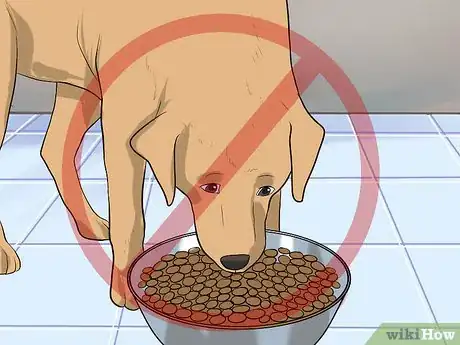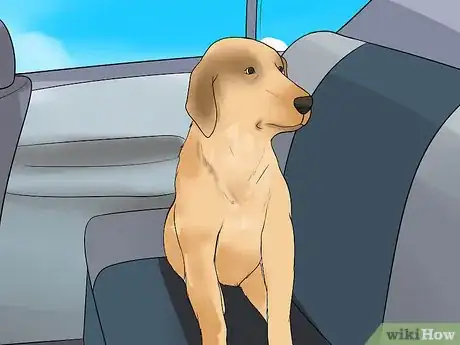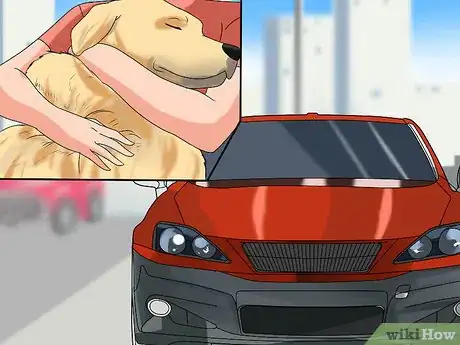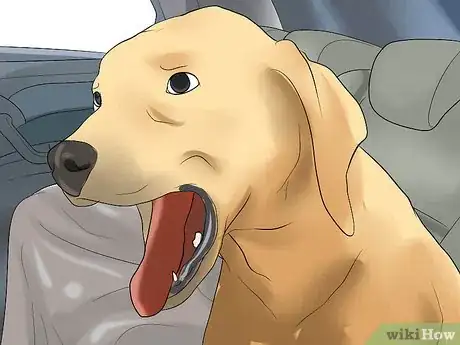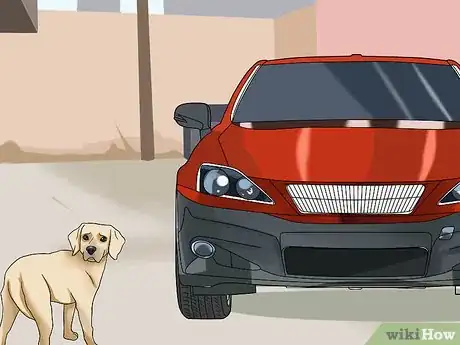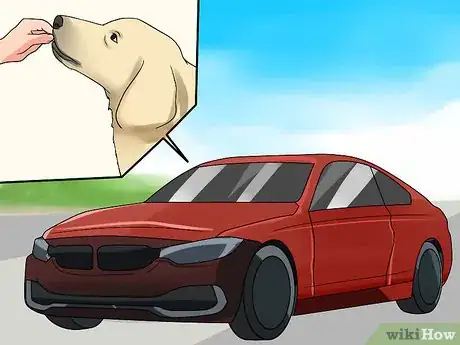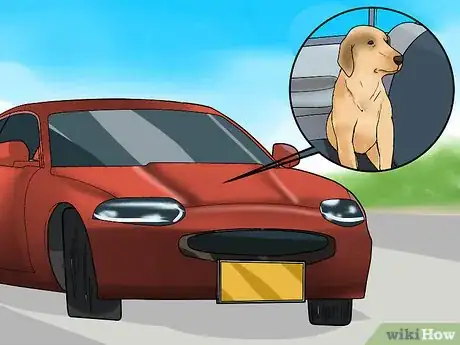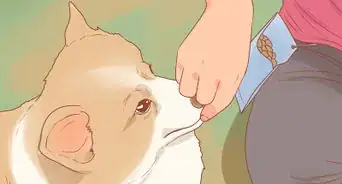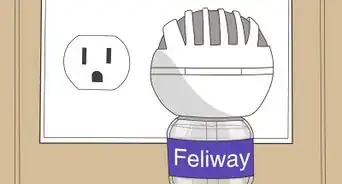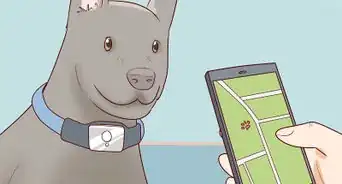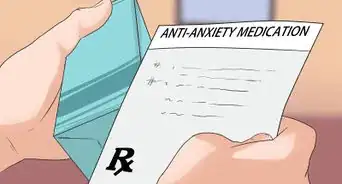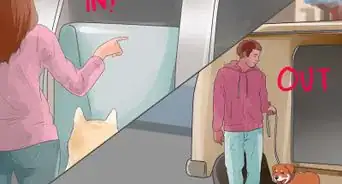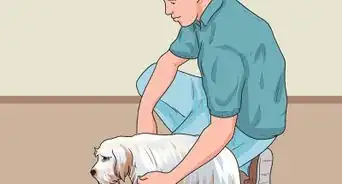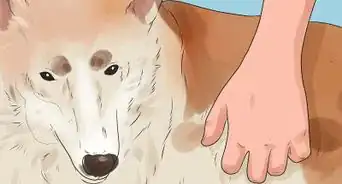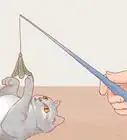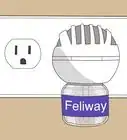This article was co-authored by Elisabeth Weiss. Elisabeth Weiss is a Professional Dog Trainer and owner of Dog Relations NYC, a dog training service in New York, New York. Elisabeth relies on science-based, force-free, and reward-based techniques. Elisabeth offers behavior training, puppy manners, body awareness and injury prevention, diet, exercise and dog nutrition services. Her work has been featured in New York Magazine and on the Dog Save the People podcast. She also trained all the dogs in the movie "Heart of a Dog" by Laurie Anderson that features Elisabeth's journey with Laurie Anderson's and Lou Reed's dog Lolabelle and how her passion for playing the keyboards played a significant role in improving her quality of life after being diagnosed with pancreatic cancer.
This article has been viewed 166,902 times.
It's important to be able to take your dog in the car without a lot of fuss. However, this can be a bit of a problem if your dog is nervous in cars. Whether you simply need to take a nervous dog on a short trip to the vet or you need to take it on a long road trip, there are steps you can take to make your dog's trip easier and the experience more pleasurable for both of you. If you love your dog and you want to take it places with you, learn how to manage and overcome its nervousness in the car.
Steps
Traveling Successfully With a Dog
-
1Make sure the dog is comfortable but safe. Always travel your dog in a crash-test approved safety device, such as a travel pod (small dogs), harness (medium-sized dogs), or crate (large dogs.) This keeps the dog safe and prevents it from distracting the driver by actions such as climbing onto his lap.
-
2Avoid giving the dog a large meal prior to travel. A good compromise is to feed the dog 3-4 hours prior to travel. You can also wait to feed your dog when you get to your destination, if your trip is short.
- Remember that a dog may feel sick even if its stomach is very empty.
Advertisement -
3Give the dog plenty of opportunity for breaks. Your dog will need toilet breaks if you are taking it for a long ride. You should also carry water and a bowl so it can have a drink during breaks in the journey.
- Get out and take your dog out to stretch its legs. This will go a long way toward soothing its sickness or nervousness.
- For long journeys exercising the dog before hand will help to burn off excess energy and help it to settle en route.
-
4Make your dog as comfortable as possible. Don't over heat the car or smoke during the journey, as this may induce nausea even in a seasoned traveler.[1] Consider using pheromones in the car, such as an Adaptil collar on the dog. This gives off hormones that reassure the dog and reduce anxiety, and may well help with his distress at being in a vehicle.[2]
- Take along something the dog finds comforting, such as a blanket that smells of home, or a favorite cuddly toy.[3]
-
5Take someone else with you until your dog gets used to being in the car. Your dog can easily distract you if it is moving around a lot in the back of the car and if it is whining or barking. Obviously any distraction while you are driving can be dangerous.
- If the dog is sitting in a rear gate, have someone pat the dog (if able) every so often. Move it if this location causes undue stress.
- Talk to your dog to reassure it. Use a calm voice and don't show panic or annoyance if it is doing something you don't want it to do. Just keep calmly talking to the dog and telling it how good it is being.
-
6Take a bag of supplies with you for your journey. It should include treats for rewards, a good strong leash, fresh cool water and a bowl to drink from, a toy or two, and plenty of cleaning up materials, such as cloths, spray cleaner, poop baggies etc. It is likely that your dog might have an accident in your car in the early days just due to plain nervousness. If you have cleaning products at hand, the long term damage to your vehicle will be minimized and you and your dog's comfort can continue for the rest of the journey.
Addressing Motion Sickness
-
1Assess whether your dog has motion sickness. Some dogs are nervous about car travel because they feel nauseous and associate journeys with feeling ill and travel sickness. Recognize the signs of motion sickness, the most obvious of which is heavy drooling. [4] Strings of saliva hanging from the dog's lips is a sure sign of motion sickness. In addition, all dogs react differently but some hang their heads and look troubled, others may try to pace, and some will whimper.
- Those dogs who suffer from motion sickness will need medication to travel well. You will need to speak to your vet about a safe medication to counteract the nausea. It might be that the dog always needs medication for long journeys, but you may well be able to retrain it to accept short journeys without illness.
-
2Be prepared for the dog to be sick. Do not shout or chastise the dog if it vomits. It cannot help being sick and being chastised only adds to its apprehension and increases the trauma of the experience, which will make it even more anxious.
- If you know your dog gets travel sick but have to make a journey, such as to the vet to get travel sickness meds, then seat it on a puppy pad so that the mess can be easily cleaned.
-
3Place your dog in a spot in the car where it can see out. It usually helps a dog if it can see out of a window. If you have a toy or small dog, consider getting a travel pod which raises it up off the seat in a safe way, so it can see out. For medium sized dogs, have a certified crash-tested harness and seat the dog on a back seat so it can see out. For large dogs, consider putting the dog in a crate, so they are safe and can see out.[5]
- You can also put a blanket underneath where the dog will be sitting. It should be a blanket that the dog uses regularly, so its smells will be familiar to the dog.
-
4Consult with your vet about whether your dog needs medication to prevent nausea. Avoid using human anti-motion sickness medications unless you have checked it out with your vet first. These are not approved for use in dogs, so the side effects have not been fully tested, and the possible reactions with other drugs is unknown. On a practical level, dogs metabolize drugs differently than people, so there is a distinct possibility that those human drugs won't be effective.
- The best medication for motion sickness is a prescription drug called Cerenia (maropitant) which is available as an injection (given by the vet) or tablet. Both forms work for 24 hours. This medication is superior to others because it acts on the nausea center in the brain, and switches off all feelings of nausea and sickness.[6]
-
5Consider alternative treatments. Some owners find giving their dog Bach flower remedies, commonly known as Rescue Remedy, helps, but this is anecdotal. This is a liquid and you place a few drops on the dog's tongue.[7] The Bach flowers are dissolved in alcohol and one possible explanation that some dogs seem to benefit is that they are given the equivalent of a small alcoholic drink.
Retraining a Nervous Dog
-
1Figure out if your dog is simply nervous, as opposed to nauseous. Some dogs dislike car journeys because they feel fearful or anxious because they had a bad experience in a car, such as being involved in a crash. It could even be that a dog is hesitant to get in the car because it got too excited and the driver shouted at it.
- It is immensely helpful to retrain the dog so that journeys become associated with a pleasant experience and therefore something to be looked forward to.[8]
-
2Avoid long journeys while retraining your dog. If your dog hates car travel, then try to avoid long journeys while you are retraining it.[9] Your aim is to build new associations with the car so that the dog thinks the car is a great place to be.[10] This is a gradual process that can't be rushed, and will actually be set back if you rush it.
-
3Begin exposing your dog to positive experiences in the car. Start with the car parked and with the engine off. Open a door and put an extra tasty treat inside.[11] Encourage the dog to jump into the stationary car and give it lots of positive attention when it does. Then let the dog come out and do something pleasurable afterwords, like take the pup for a walk.
- Then start feeding the dog meals in the stationary car. Protect the upholstery with a towel or puppy pad, place the food bowl on top, and get it used to taking meals in the stationary car.
- Consider stuffing a Kong and giving it to the dog in the stationary car. Think of different activities which your dog enjoys and make them happen in the car. It could be it takes weeks or months until the dog is willingly jumping into the vehicle, in anticipation of the "good thing", but eventually he will learn.
-
4Transition to pleasurable experiences while the car is on and moving. Once the dog is comfortable in the stationary car, start taking ultra short trips. Initially, these are as limited as starting the engine, letting it run, then turning it off. Then try backing out of the driveway, and straight back in.
- Build up to a short trip round the block. Then a short drive round the neighbourhood.
- This is all about gradual adjustments, so don't rush it. Make sure your dog is really comfortable with a phase before moving forward.[12]
- If you can have someone go with you to watch the dog for signs of distress or nausea. If this happens, stop the car, take the dog out and let it walk around for a bit to give it relief. Complete the journey and next time don't go so far.
- In these early days, try to visit places that are fun, so the journey has a reward at the end of it, such as a park or woods.
Expert Q&A
Did you know you can get expert answers for this article?
Unlock expert answers by supporting wikiHow
-
QuestionWhat should I do if my dog is afraid to get in the car?
 Elisabeth WeissElisabeth Weiss is a Professional Dog Trainer and owner of Dog Relations NYC, a dog training service in New York, New York. Elisabeth relies on science-based, force-free, and reward-based techniques. Elisabeth offers behavior training, puppy manners, body awareness and injury prevention, diet, exercise and dog nutrition services. Her work has been featured in New York Magazine and on the Dog Save the People podcast. She also trained all the dogs in the movie "Heart of a Dog" by Laurie Anderson that features Elisabeth's journey with Laurie Anderson's and Lou Reed's dog Lolabelle and how her passion for playing the keyboards played a significant role in improving her quality of life after being diagnosed with pancreatic cancer.
Elisabeth WeissElisabeth Weiss is a Professional Dog Trainer and owner of Dog Relations NYC, a dog training service in New York, New York. Elisabeth relies on science-based, force-free, and reward-based techniques. Elisabeth offers behavior training, puppy manners, body awareness and injury prevention, diet, exercise and dog nutrition services. Her work has been featured in New York Magazine and on the Dog Save the People podcast. She also trained all the dogs in the movie "Heart of a Dog" by Laurie Anderson that features Elisabeth's journey with Laurie Anderson's and Lou Reed's dog Lolabelle and how her passion for playing the keyboards played a significant role in improving her quality of life after being diagnosed with pancreatic cancer.
Professional Dog Trainer
-
QuestionMy dog goes back and forth in the backseat of the truck, how do I stop him?
 Community AnswerYou could secure him with a harness or doggy seat belt. Just make sure it's safe and comfortable for the dog.
Community AnswerYou could secure him with a harness or doggy seat belt. Just make sure it's safe and comfortable for the dog. -
QuestionMy dog loves to be in the car when it's not moving, and sometimes will just randomly hop in if I leave a door open. But whenever we are going somewhere, she will whine and cry and it is terribly annoying. How do I get her to settle down?
 Community AnswerGive her a chew or have a passenger sit her down next to her and stroke her comfortingly.
Community AnswerGive her a chew or have a passenger sit her down next to her and stroke her comfortingly.
References
- ↑ http://www.preventivevet.com/dogs/preventing-travel-anxiety-and-carsickness-in-dogs
- ↑ http://www.preventivevet.com/dogs/preventing-travel-anxiety-and-carsickness-in-dogs
- ↑ http://www.preventivevet.com/dogs/preventing-travel-anxiety-and-carsickness-in-dogs
- ↑ https://www.aspca.org/pet-care/virtual-pet-behaviorist/dog-behavior/fear-riding-cars
- ↑ https://www.cesarsway.com/dog-care/travel/cesars-travel-tips
- ↑ Plumb's Veterinary drug handbook. Donald Plumb.
- ↑ http://animalwellnessmagazine.com/flower-essences-for-anxious-dogs/
- ↑ Elisabeth Weiss. Professional Dog Trainer. Expert Interview. 3 September 2020.
- ↑ http://www.preventivevet.com/dogs/preventing-travel-anxiety-and-carsickness-in-dogs
- ↑ https://www.aspca.org/pet-care/virtual-pet-behaviorist/dog-behavior/fear-riding-cars
- ↑ Elisabeth Weiss. Professional Dog Trainer. Expert Interview. 3 September 2020.
- ↑ Elisabeth Weiss. Professional Dog Trainer. Expert Interview. 3 September 2020.
About This Article
To calm a nervous dog in the car, give it something comforting, like one of its blankets or a toy. If your dog is very nervous, have someone sit with it to keep it calm and out of your lap. You should also try to make frequent stops so your dog can go to the bathroom and stretch its legs. In more severe cases, it may help to have your dog wear an Adaptil collar, which gives off calming hormones. To learn from our Veterinary reviewer how you can identify and treat nausea in dogs, keep reading!

